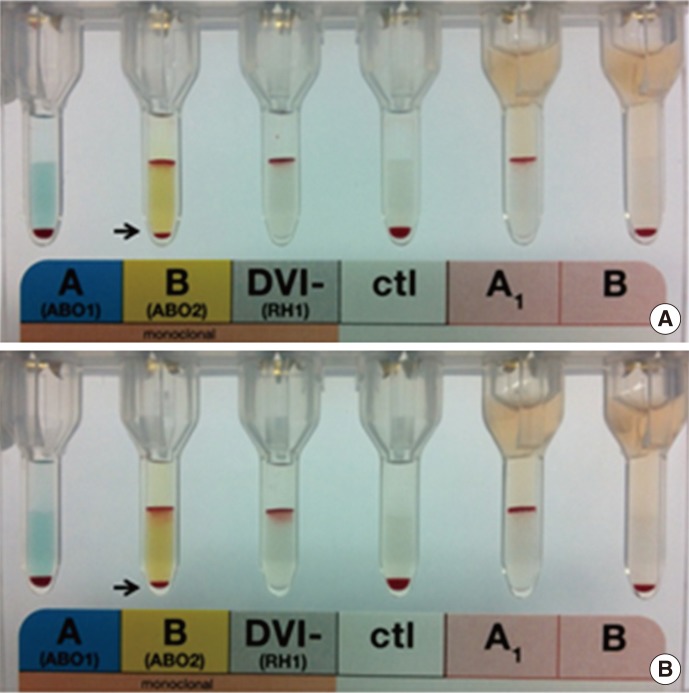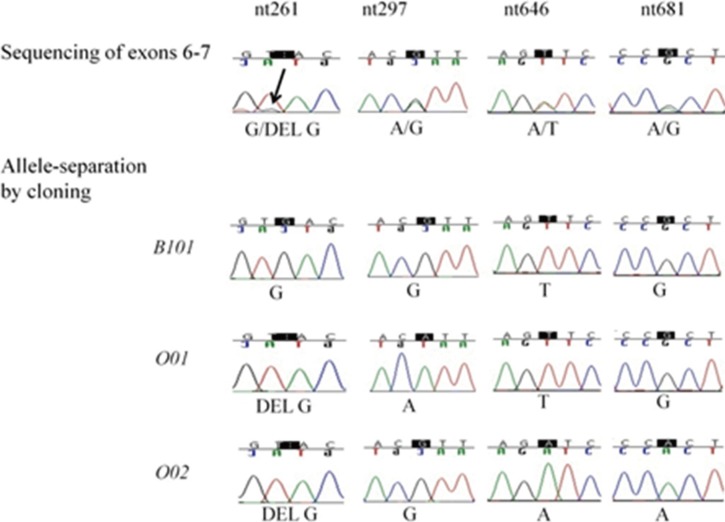This article has been
cited by other articles in ScienceCentral.
Dear Editor,
Monochorionic (MC) dizygotic twins (DZT) are rarely conceived naturally [
1]. However, the number of pregnancies conceived by assisted reproductive technology (ART) has increased from 9,864 in 1994 to 29,733 in 2006, thus multiple birth rate increased from 10/1,000 live births in 1980's to 27.5/1,000 live births in 2008 in Korea [
2]. All MC DZT are theoretically chimeric for blood cells because blood stem cells might be exchanged through the common (MC) placenta [
1,
3]. To date, there is no report on MC DZT exhibiting blood group chimerism in Korea. There has been only one reported instance of blood group chimerism in a dizygotic dichorionic pregnancy, even though IVF-ET is widely used in Korea [
2,
4]. We report blood group chimerism in sex-discordant MC DZT conceived via IVF-ET, initially misdiagnosed at birth as having blood subgroup B3.
The sex-discordant MC DZT conceived via IVF-ET were born at a tertiary university hospital and assigned the blood subgroup B3. Twenty-three months later, the male twin (propositus) visited the same hospital for a preoperative workup prior to hydrocele surgery. Approximately a half of his red blood cells (RBCs) agglutinated strongly (4+) with anti-B reagents on forward typing, whereas the remaining RBCs did not (mixed field agglutination). His serum reacted with A
1 RBCs only. His father, mother, and older sister had typical B, O, and B phenotypes, respectively (
Fig. 1). Retrospective medical record review revealed that the propositus did not have any history of transfusion and bone marrow transplantation and, interestingly, he and his twin sister were MC twins.
 | Fig. 1Blood groups of the propositus and his family. The phenotypes and genotypes of the propositus' family members (except his twin sister) were normal. Mixed blood of types B and O, caused by the genotype B101/O01/O02 (as revealed by cloning and direct sequencing of exons 6 and 7) was observed in the propositus (arrow) and his twin sister. 
|
To confirm blood group chimerism, the following tests were performed on the twins and their father, mother, and sister, after obtaining their informed consent: 1) ABO serological testing using a micro-column agglutination technique (Bio-Rad, Cressier sur Morat, Switzerland); 2) ABO genotyping via direct sequencing of exons 6 and 7; 3) allelic separation of the ABO gene via cloning; and 4) short tandem repeat (STR) marker analysis. All tests were performed as described previously [
5,
6]. The results are summarized in
Fig. 1,
2, and
3. In addition, STR analysis of buccal swabs, hair follicle material, and peripheral blood leukocytes from the propositus and his twin sister, was performed to discriminate between whole-body and blood chimerisms. Six loci (D21S11, D13S317, D2S1338, TPOX, D18S51, and FGA) yielded three or more peaks in DNA obtained from peripheral blood leukocytes, but not in DNA obtained from buccal swabs or hair follicles (
Table 1). This result confirmed that chimerism in these MC DZT was confined to blood cells.
 | Fig. 2
Results of the monoclonal gel test showing two populations of blood cells on typing of the propositus. A mixed-field agglutination pattern was observed by using the anti-B reagent (arrows), indicating the simultaneous presence of two red blood cell populations (Twin, male, A). The same pattern was observed in the twin sister of the propositus (Twin, Female, B).
Abbreviations: DVI, RhDVI variants; ctl, control.

|
 | Fig. 3
Nucleotide sequences in the region of nucleotides 261 (arrow), 297, 646, and 681 in ABO exons 6 and 7. The top chromatogram was produced by routine sequencing of exons 6 and 7. The presence of both O01- and O02-allele-specific nucleotides and B-allele-specific nucleotides (arrow) is evident. The bottom three chromatograms were obtained via sequencing conducted after cloning, and conclusively show B101-, O01-, and O02-allele-specific nucleotides.
Abbreviation: nt, nucleotide.

|
Table 1
Short tandem repeat analysis of DNA isolated from the blood, buccal swab, and hair root cells of the propositus and his twin sister


A chimera is defined as an organism carrying cells from two or more zygotes [
7]. When chimerism is confined to the lymphohematopoietic system and occurs spontaneously in twins, the condition is termed "twin blood chimerism" [
7]. The twins described in the present report displayed overt blood group chimerism because of their MC history. The blood cells were approximately 50% O and 50% B (
Fig. 2). However, the twins were initially misdiagnosed as having blood subgroup B3 at birth, and the propositus was only later shown to exhibit blood group chimerism.
Clinical, serological, and molecular studies of patients and their families may be useful in distinguishing blood group chimerism from ABO subgroups such as B3. The present case was characterized by using the following criteria: an MC DZT, no evidence of subgroup B3 in his parents, distinct double cell populations in micro-column, more than three ABO alleles, and three or more STR peaks in six loci. Thus, the propositus was suspected to exhibit blood group chimerism rather than to be of subgroup B3. The flow cytometry for the detection of A/B antigens of red blood cells might also be useful in discriminating between chimerism and ABO subgroups [
8].
In terms of clinical implications, blood chimerism in MC DZT may be a risk factor for the development of particular complications such as twin-to-twin transfusion syndrome. Blood group chimerism may also cause confusion, if a blood transfusion is required or an ABO discrepancy occurs [
1,
5,
6]. Thus, accurate diagnosis of twin blood chimerism is essential.
ART such as IVF-ET is widely used in Korea, and the frequency of MC DZT may be increasing [
2]. The use of ART, including IVF-ET, may affect cell fusion, adhesion, and embryo proximity [
9], and is likely to increase the probability of monochorionicity in DZT. Thus, many Korean MC DZT are likely to have blood group chimerism. Unexpectedly, this is the first reported case of blood group chimerism in MC DZT conceived via IVF-ET in Korea, suggesting that blood group chimerism in MC DZT may be overlooked in Korean hospitals and blood banks.
Acknowledgments
We would like to thank Hye Ryoen Park for her technical assistance. This work was supported by a research grant from the Research Institute of Medical Sciences, Chonnam National University (2012-CURIMS-DR001).
Go to :

Notes
Go to :

References
1. Miura K, Niikawa N. Do monochorionic dizygotic twins increase after pregnancy by assisted reproductive technology? J Hum Genet. 2005; 50:1–6. PMID:
15599781.

2. Park YS, Choi SH, Shim KS, Chang JY, Hahn WH, Choi YS, et al. Multiple births conceived by assisted reproductive technology in Korea. Korean J Pediatr. 2010; 53:880–885. PMID:
21189958.

3. Ekelund CK, Skibsted L, Sogaard K, Main KM, Dziegiel MH, Schwartz M, et al. Dizygotic monochorionic twin pregnancy conceived following intracytoplasmic sperm injection treatment and complicated by twin-twin transfusion syndrome and blood chimerism. Ultrasound Obstet Gynecol. 2008; 32:832–834. PMID:
18956441.

4. Jang JH, Jung H, Kim JH, Park WS, Kim SH. Blood chimerism in a dizygotic dichorionic pregnancy. Korean J Lab Med. 2010; 30:521–524. PMID:
20890086.

5. Cho D, Lee JS, Yazer MH, Song JW, Shin MG, Shin JH, et al. Chimerism and mosaicism are important causes of ABO phenotype and genotype discrepancies. Immunohematology. 2006; 22:183–187. PMID:
17430077.

6. Won EJ, Park HR, Park TS, Oh SH, Shin MG, Shin JH, et al. Amplification refractory mutation system-PCR is essential for the detection of chimaeras with a minor allele population: a case report. J Clin Pathol. 2013; 66:446–448. PMID:
23418339.

7. Bluth MH, Reid ME, Manny N. Chimerism in the immunohematology laboratory in the molecular biology era. Transfus Med Rev. 2007; 21:134–146. PMID:
17397763.

8. Hult AK, Olsson ML. Many genetically defined ABO subgroups exhibit characteristic flow cytometric patterns. Transfusion. 2010; 50:308–323. PMID:
19804572.

9. Assaf SA, Randolph LM, Benirschke K, Wu S, Samadi R, Chmait RH. Discordant blood chimerism in dizygotic monochorionic laser-treated twin-twin transfusion syndrome. Obstet Gynecol. 2010; 116(Suppl 2):483–485. PMID:
20664426.

Go to :








 PDF
PDF ePub
ePub Citation
Citation Print
Print



 XML Download
XML Download